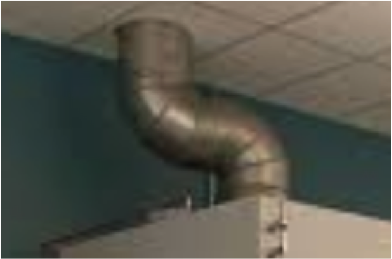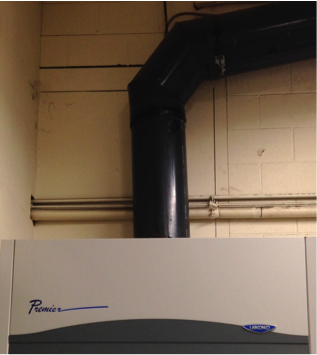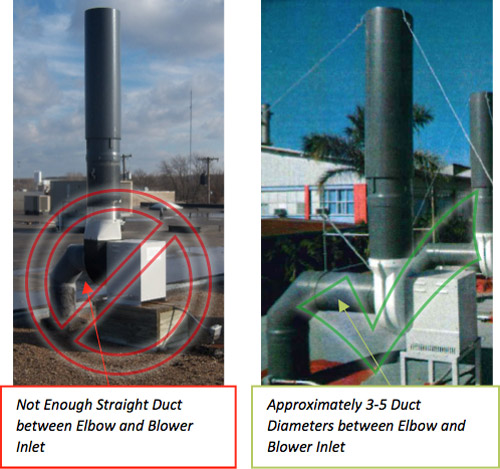The “Ugly Ducting” Layout
 Duct layouts are of great importance to the success of a fume hood mechanical system. The ductwork path affects things like airflow efficiency and the noise level of the system.
Duct layouts are of great importance to the success of a fume hood mechanical system. The ductwork path affects things like airflow efficiency and the noise level of the system.
Placing an elbow immediately following the fume hood exhaust collar (see image at right) creates unnecessary turbulence within the duct and also adds unwanted, excess noise. Therefore, it is recommended to allow at least 3-5 duct diameters of straight ducting between bends in the mechanical system (image below, left). This applies to all bends from the top of the fume hood to the blower inlet.
Every bend in the system creates additional static pressure (or resistance). For example, a 12” diameter, 90 degree elbow adds 25’ of equivalent resistance! That means adding a single elbow is equivalent to adding 25 extra feet of straight duct to your system. So it’s a good idea to limit the number of bends included in the duct layout to keep the system as efficient as possible.
Fume hoods do not generate noise. In fact, tests show that Labconco Fume Hoods actually dampen the noise generated by the building’s mechanical system. Using flexible ductwork and vibration isolators to cut down on the excess noise created by the air inside the ductwork is recommended. The smoother the airflow, the quieter the system will be; so make sure your mechanical system’s design is conducive to smooth airflow to ensure a more enjoyable experience for the fume hood user. Installations that do not follow this best practice may experience blower inefficiencies and more noise than a traditional installation.
SYMPTOM: Loud system, blower not pulling as much as it should (inefficent airflow).
SOLUTION: Incorporate vibration isolators on your blower curb, add flex duct, and eliminate ductwork bends where possible.


Return to the main article, "3 reasons your fume hood isn't working as it should".
| chevron_left | No-No Fume Hood Placement | Articles | Ceiling Enclosures and Negative Ceiling Pressure | chevron_right |






